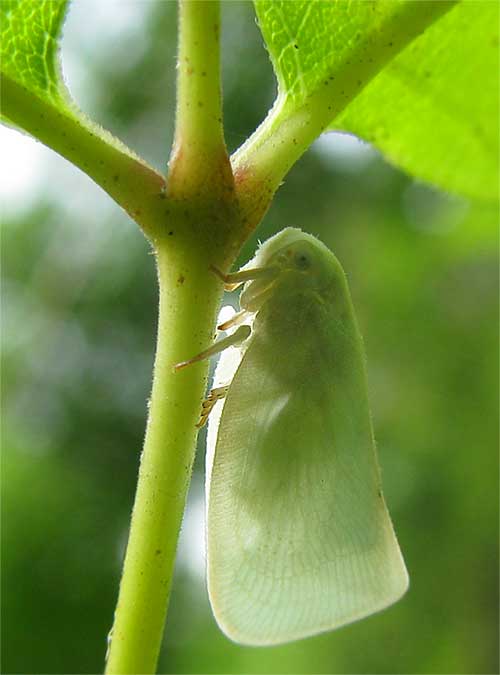Excerpts from Jim Conrad's
Naturalist Newsletter
from the June 16, 2008 Newsletter, issued from the forest near Natchez, Mississippi; elevation ~400ft (120m), ~N31.47°, ~W91.29°:
NORTHERN FLATID PLANTHOPPER

Above you may recognize a sap-sucking insect you've seen many times. Sometimes a whole line of them can be seen feeding on something like a snapbean stem, one above the other, each with its tiny, strawlike proboscis inserted into the plant's stem, sucking sap. It's a flatid planthopper, a member of the large and widely distributed family Flatidae. The Flatidae belong to the Homoptera order, in which we also find cicadas, aphids, spittlebugs and scale insects. Planthoppers are NOT moths, despite having mothlike wings. Many genera and species occur in the family but I'm guessing that the individual in the picture belongs to the genus Anormenis*.
If you get too close to a planthopper, instead of flying or hopping away, usually it'll quickly shift to the stem's opposite side so you can't see it. If there's a line of planthoppers, one above the other, they may all move at the same time, which is funny to see. Typically as they're feeding they hang with their wings downward exactly as in the photo.
Other kinds of planthoppers occur besides flatids, plus scattered among various homopterid families there are froghoppers, leafhoppers and treehoppers. Besides the round-headed wedge shape, one distinguishing feature of flatid planthoppers is the way many straight, outward radiating, parallel veins run around the wings' margins, as shown in the photo. The technical way of saying that is "numerous costal cross veins."